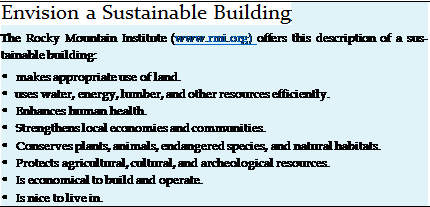Sustainability, as applied today, has many definitions. It is being energy efficient, but much more. Most definitions of sustainability revolve around the idea of balance, thinking of the future and minimizing impact today. Sustainability issues in buildings include energy efficiency, water management, air quality, waste management, and recycling. There are sustainable practices, products, and techniques in the design and construction of a building. Sustainability is also a philosophical approach that guides design and business decisions.
 |
In recent years, the term green building has come to represent policies and practices that are environmentally responsible—sustainable. Sustainable, green building practices are recognized to:
• Promote healthy places to live and work.
• Enhance and protect natural ecosystems and biodiversity.
• Improve air and water quality.
• Reduce solid waste.
• Conserve natural resources.
For the designer, there are many opportunities to implement sustainable design policies and practices. A general overview is presented in the following list. This chapter will further detail many opportunities to practice sustainability that are particularly applicable to bathroom design and construction.
• Think small, compact—minimalist. A smaller space is a more sustainable space. Fewer materials are used in the constructing of a smaller space. There is less space to heat and cool. Less energy is needed for lighting (see Figure 3.1).
• Specify environmentally healthy building and interior finish materials, including nontoxic, sustainably harvested, recycled, or renewable resource products. Look for opportunities to reuse materials through salvage or repurposing.
• Specify materials and products from local sources to minimize the energy or pollution "cost" for transportation.
• Specify products, including appliances, which are energy efficient.
• Specify plumbing fixtures and appliances that conserve water.
• Maximize the use of daylight and specify energy-efficient light sources.
• Plan window placement to maximize passive solar gain through south-facing windows. Minimize heat loss through north windows and limit heat gain though west windows.
• Plan the layout of the bathroom and auxiliary spaces to maximize the use of standard size materials and products, minimizing the amount of construction waste.
• Investigate and implement opportunities to recycle construction and demolition waste. Encourage clients to donate serviceable cabinetry, appliances, and fixtures removed in renovations to charitable organizations.



